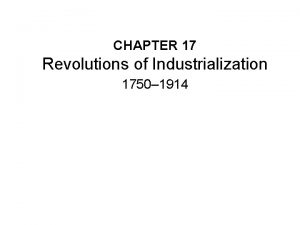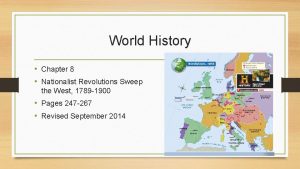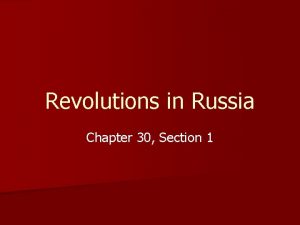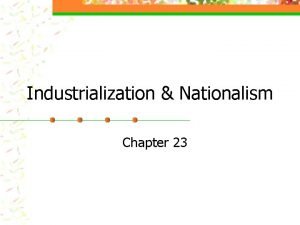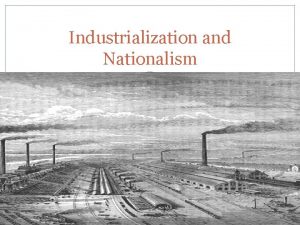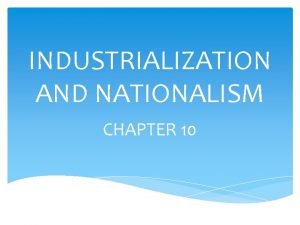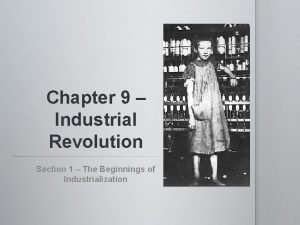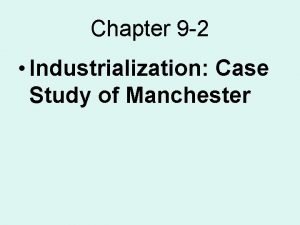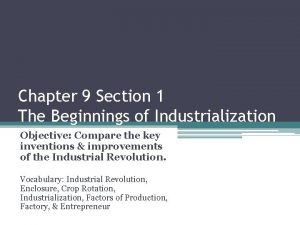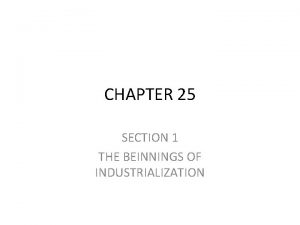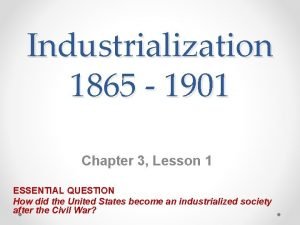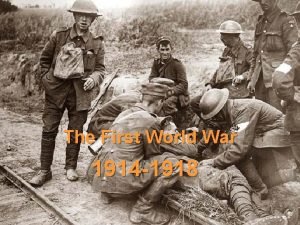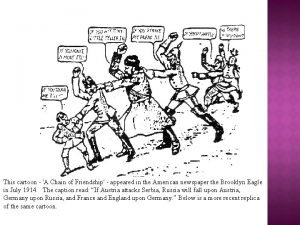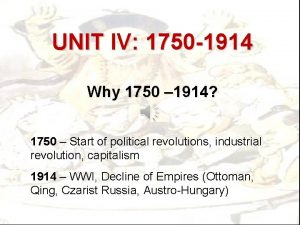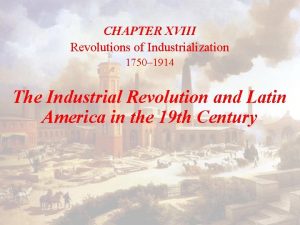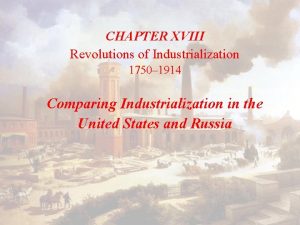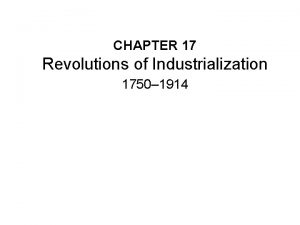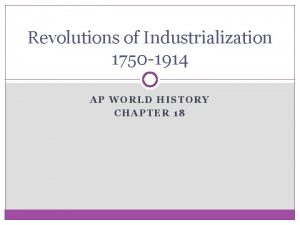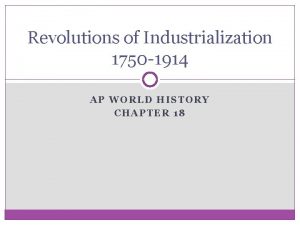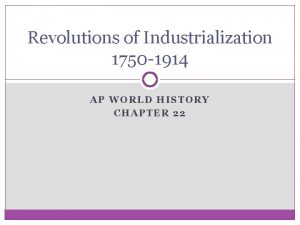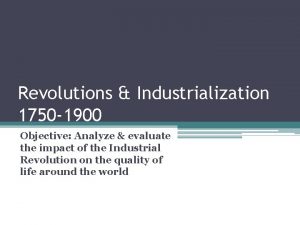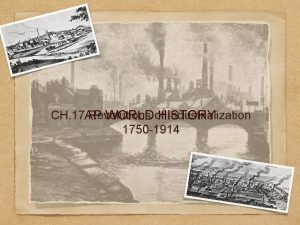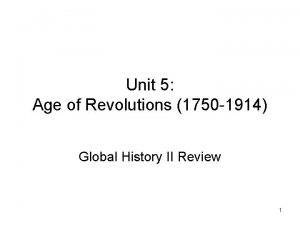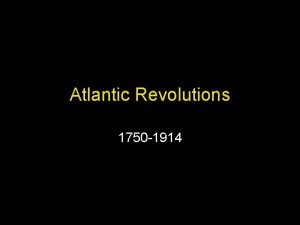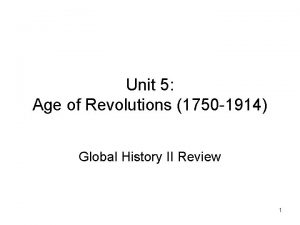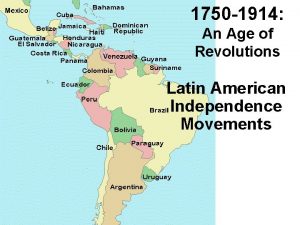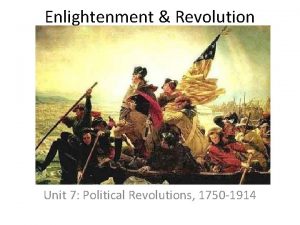CHAPTER 17 Revolutions of Industrialization 1750 1914 I
































- Slides: 32

CHAPTER 17 Revolutions of Industrialization 1750– 1914


I. Explaining the Industrial Revolution A. Why Europe? 1. Technology, science, and economics elsewhere 2. Competition within Europe 3. State-merchant alliances 4. Competition with Asian imports 5. The American windfall: silver, sugar, slaves, and more


I. Explaining the Industrial Revolution B. Why Britain? 1. Colonies, commercial society, and political security 2. Practical, not theoretical, science 3. Lucky geography

II. The First Industrial Society A. The British Aristocracy 1. Landowners remained wealthy 2. Overall decline in class power 3. Turn to the empire


II. The First Industrial Society B. The Middle Classes 1. An amorphous group 2. Classical Liberalism 3. Samuel Smiles, Self-Help 4. Women: paragons of “respectability” 5. The lower middle class


II. The First Industrial Society C. The Laboring Classes 1. 70 percent of Britain 2. Rapid urbanization 3. New working conditions 4. Women and girls in the factory?


II. The First Industrial Society D. Social Protest 1. Trade unions, 1824 2. Robert Owen (1771– 1858) 3. Karl Marx’s (1818– 1883) “scientific socialism”


II. The First Industrial Society D. Social Protest 4. Labor Party and 1910– 1913 strikes 5. British reform (and nationalism), not revolution 6. Competition and decline


II. The First Industrial Society E. Europeans in Motion 1. Migration to cities and other continents 2. Settler colonies 3. “White” Europeans in Latin America


II. The First Industrial Society E. Europeans in Motion 4. Opportunities and diversity in the United States 5. Russians and Ukrainians to Siberia

III. Variations on a Theme: Industrialization in the United States and Russia A. The United States: Industrialization without Socialism 1. Explosive growth 2. Pro-business legislation 3. Mass production for a mass market 4. Ford, Carnegie, and Rockefeller as cultural heroes 5. Difficult working and living conditions


III. Variations on a Theme: Industrialization in the United States and Russia A. The United States: Industrialization without Socialism 6. Strikes and class conflict but weak political organization 7. Conservative unions, racial politics, and high standards of living 8. Populists and Progressives but few Socialists


III. Variations on a Theme: Industrialization in the United States and Russia B. Russia: Industrialization and Revolution 1. A complete opposite of the United States of America 2. State-sponsored change 3. Rapid industrialization produces social conflicts 4. Small but very radical proletariat


III. Variations on a Theme: Industrialization in the United States and Russia B. Russia: Industrialization and Revolution 5. Russian Social-Democratic Labor Party 6. 1905: Revolution, repression, and reluctant reforms 7. Growth of revolutionary parties 8. 1917: Lenin and the Bolsheviks


IV. The Industrial Revolution and Latin America in the Nineteenth Century A. After Independence in Latin America 1. Turbulent international and domestic politics 2. Caudillos 3. Caste War of Yucatán (1847– 1901)

IV. The Industrial Revolution and Latin America in the Nineteenth Century B. Facing the World Economy 1. Steam ships and telegrams 2. Exports to the industrializing world 3. Imported industrial goods 4. Foreign capital investment


IV. The Industrial Revolution and Latin America in the Nineteenth Century C. Becoming like Europe? 1. A Eurocentric elite 2. Urbanization 3. Solicitation of European immigrants 4. Few saw economic benefits from exports 5. Growth of unions and strikes provokes repression


IV. The Industrial Revolution and Latin America in the Nineteenth Century C. Becoming like Europe? 6. Rural poverty 7. Mexican Revolution (1910– 1920) 8. “Dependent Development” and “Banana Republics” 9. American intervention
 Chapter 17 revolutions of industrialization
Chapter 17 revolutions of industrialization Chapter 8 nationalist revolutions sweep the west
Chapter 8 nationalist revolutions sweep the west Chapter 30 section 1 revolutions in russia
Chapter 30 section 1 revolutions in russia Chapter 14 section 1 revolutions in russia answer key
Chapter 14 section 1 revolutions in russia answer key Atlantic revolutions in a global context
Atlantic revolutions in a global context How were european rulers guided by enlightenment thought?
How were european rulers guided by enlightenment thought? Which ideas of romanticism would encourage nationalism
Which ideas of romanticism would encourage nationalism Atlantic revolutions and their echoes
Atlantic revolutions and their echoes Industrialization spreads chapter 9 section 3
Industrialization spreads chapter 9 section 3 Chapter 9 section 3 industrialization spreads answer key
Chapter 9 section 3 industrialization spreads answer key Chapter 9 section 3 industrialization spreads answer key
Chapter 9 section 3 industrialization spreads answer key Chapter 23 industrialization and nationalism
Chapter 23 industrialization and nationalism Lesson quiz 10-2 industrialization and nationalism answers
Lesson quiz 10-2 industrialization and nationalism answers -have strength to match the growth of industrialization
-have strength to match the growth of industrialization Chapter 9 section 1 the beginnings of industrialization
Chapter 9 section 1 the beginnings of industrialization Chapter 9 section 2 industrialization case study manchester
Chapter 9 section 2 industrialization case study manchester Chapter 9 section 1 the beginnings of industrialization
Chapter 9 section 1 the beginnings of industrialization The beginnings of industrialization chapter 25 section 1
The beginnings of industrialization chapter 25 section 1 Chapter 3 industrialization (1865 to 1901 answers)
Chapter 3 industrialization (1865 to 1901 answers) In 1914, who controlled the shaded areas on the map?
In 1914, who controlled the shaded areas on the map? Európa térképe 1914-ben
Európa térképe 1914-ben Colonial empires 1914
Colonial empires 1914 Dinant 1914
Dinant 1914 Imperialism map 1914
Imperialism map 1914 Triple alianza y triple entente
Triple alianza y triple entente Topovsko pitanje
Topovsko pitanje Ma jolie
Ma jolie Els imperis colonials
Els imperis colonials Drugo razdoblje u hrvatskoj književnosti
Drugo razdoblje u hrvatskoj književnosti Hrvatska književnost od 1914 do 1952
Hrvatska književnost od 1914 do 1952 Picasso ma jolie 1914
Picasso ma jolie 1914 Colonial empires 1914
Colonial empires 1914 Chain of friendship cartoon explained
Chain of friendship cartoon explained
